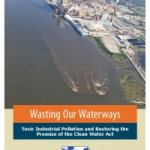Wasting Our Waterways
Toxic Industrial Pollution and Restoring the Promise of the Clean Water Act
Industrial facilities continue to dump millions of pounds of toxic chemicals into America’s rivers, streams, lakes and ocean waters each year – threatening both the environment and human health. To curb this massive release of toxic chemicals into our nation’s water, we must step up Clean Water Act protections for our waterways and require polluters to reduce their use of toxic chemicals.
Downloads
Environment Virginia Research & Policy Center

Executive Summary
Industrial facilities continue to dump millions of pounds of toxic chemicals into America’s rivers, streams, lakes and ocean waters each year – threatening both the environment and human health. According to the U.S. Environmental Protection Agency (EPA), toxic discharges from industrial facilities are responsible for polluting more than 17,000 miles of rivers and about 210,000 acres of lakes, ponds and estuaries nationwide.
To curb this massive release of toxic chemicals into our nation’s water, we must step up Clean Water Act protections for our waterways and require polluters to reduce their use of toxic chemicals.
Industrial facilities dumped 206 million pounds of toxic chemicals into American waterways in 2012, according to reports from those facilities to the national Toxics Release Inventory (TRI). (See Table ES-1 and Figure ES-1.)
- Our nation’s iconic waterways are still threatened by toxic pollution – with polluters discharging chemicals into the following watersheds: Great Lakes (8.39 million pounds), Chesapeake Bay (3.23 million pounds), Upper Mississippi River (16.9 million pounds), and Puget Sound (578,000 pounds), among other national treasures. (See Figure ES-2.)
- Polluters released toxic chemicals to 850 local watersheds across the country. Indiana led the nation in total volume of toxic releases to waterways, with more than 17 million pounds of discharges from industrial facilities, followed by Texas and Louisiana. The top 10 states for toxic industrial releases to waterways were the same as in 2010. (See Table ES-2.)
- Watersheds receiving the highest volumes of toxic pollution were the Lower Ohio River-Little Pigeon River (Indiana, Illinois and Kentucky), the Upper New River (Virginia) and the Middle Savannah River (Georgia and South Carolina). (See Table ES-3.)
Table ES-1. Industrial Toxic Releases by Watershed Region
Watershed Region
Total Pounds Released
Toxicity Weighted Pounds
Texas-Gulf
13,211,652
33,935,900
South Atlantic-Gulf
37,715,213
4,472,145
Lower Mississippi River
13,933,267
3,473,041
Pacific Northwest
6,472,813
1,292,540
Great Basin
1,275,484
1,070,625
Tennessee River
6,261,817
874,903
Arkansas-White-Red Rivers
13,005,273
611,570
Ohio River
43,103,836
496,583
Great Lakes
8,402,059
220,180
Souris-Red-Rainy Rivers
138,939
186,473
Upper Mississippi River
16,863,867
159,216
Mid Atlantic
23,690,915
131,270
Missouri River
14,878,771
105,362
Hawaii
435,662
40,131
New England
3,336,235
34,402
California
2,358,874
33,280
Upper Colorado River
22,143
2,038
Alaska
570,475
1,958
Lower Colorado River
3,632
1,906
Rio Grande River
35,857
333
Several of these watershed regions contain multiple outlets to the ocean. Toxics released in these areas do not all follow the same path to the sea.
Figure ES-1. Industrial Discharges of Toxic Chemicals to Waterways by Watershed Region

Table ES-2. Top 10 States for Toxic Releases to Water in 2012
State
Total Releases (lbs.)
Indiana
17,761,310
Texas
16,476,093
Louisiana
12,618,616
Alabama
12,287,252
Virginia
11,821,961
Nebraska
10,506,483
Pennsylvania
10,470,231
Georgia
10,132,268
North Carolina
8,897,062
Ohio
7,567,720
